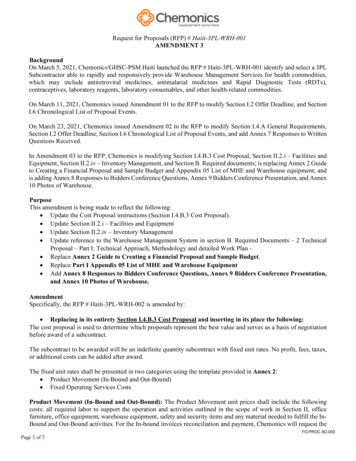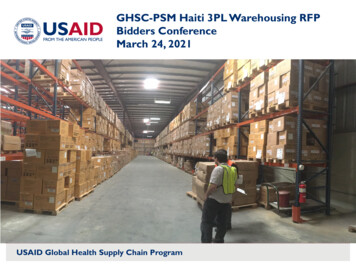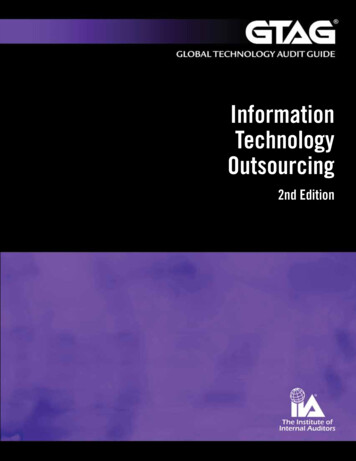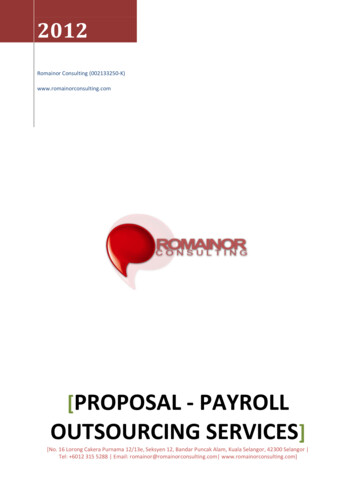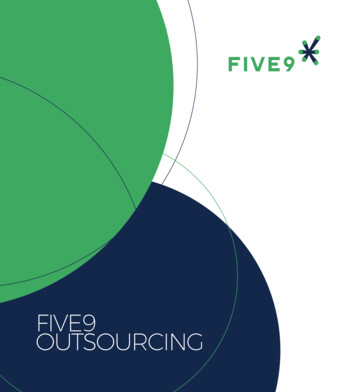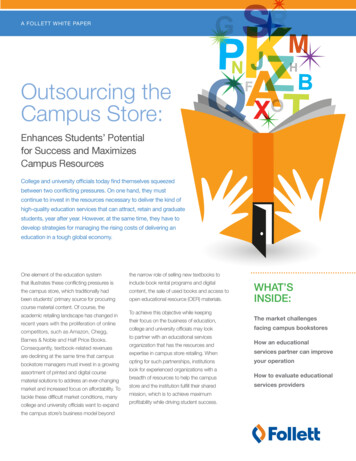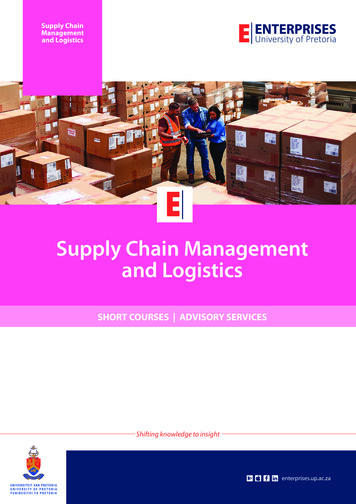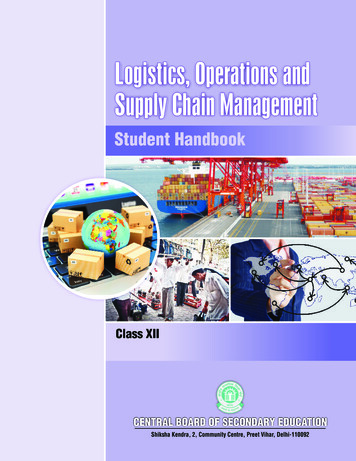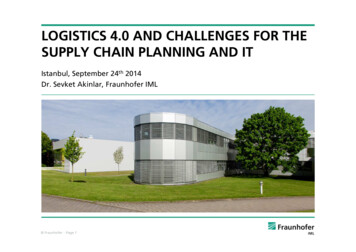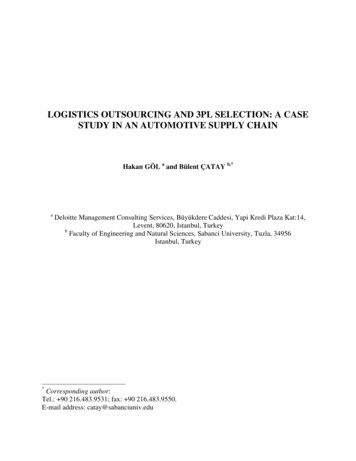
Transcription
LOGISTICS OUTSOURCING AND 3PL SELECTION: A CASESTUDY IN AN AUTOMOTIVE SUPPLY CHAINHakan GÖL a and Bülent ÇATAY b,*a*Deloitte Management Consulting Services, Büyükdere Caddesi, Yapi Kredi Plaza Kat:14,Levent, 80620, Istanbul, TurkeybFaculty of Engineering and Natural Sciences, Sabanci University, Tuzla, 34956Istanbul, TurkeyCorresponding author:Tel.: 90 216.483.9531; fax: 90 216.483.9550.E-mail address: catay@sabanciuniv.edu
H. Göl & B. Çatay2LOGISTICS OUTSOURCING AND 3PL SELECTION: A CASE STUDY INAN AUTOMOTIVE SUPPLY CHAINABSTRACTOutsourcing logistics functions to third-party logistics (3PL) providers has been a source ofcompetitive advantage for most companies. Companies cite greater flexibility, operationalefficiency, improved customer service levels, and a better focus on their core businesses as partof the advantages of engaging the services of 3PL providers. There are few complete andstructured methodologies for selecting a 3PL provider. This paper discusses how one suchmethodology, namely the Analytic Hierarchy Process (AHP), is used in an automotive supplychain for export parts to redesign the logistics operations and to select a global logistics serviceprovider.Keywords: Outsourcing, Third-Party Logistics, 3PL, Analytic Hierarchy Process, AHP, MultipleCriteria Decision-Making
H. Göl & B. Çatay31. INTRODUCTIONThere is a fundamental paradigm shift exhibited by many firms as they transform their supplychain capabilities from an industrial to an information technology driven society. Substantialchange is foreseen in logistics practices between supply chain partners as they struggle toestablish efficient, effective, and relevant product or service solutions for end customers andemphasize the “vertical to virtual integration trend” with a high implementation potential in theten mega-trends of the new millennium. The problem with the vertical integration is that itrequires significant capital investment and complex organizational structure. Companies must tiethe expertise and synergy of external supply chain partners together to achieve success. Virtuallyintegrating operations with material and service suppliers to form a seamless flow of internal andexternal work overcomes the financial barriers of vertical ownership while retaining many of thebenefits [3].Outsourcing logistics functions to third-party logistics (3PL) providers has been a sourceof competitive advantage for most companies. Companies cite greater flexibility, operationalefficiency, improved customer service levels, and a better focus on their core businesses as partof the advantages of engaging the services of 3PL providers. 3PL alliances began withcompanies outsourcing some or all of their transportation and distribution functions. In recenttimes, most 3PLs have gone from offering a single function to integrated logistics provision,offering two or more functions at the same time. Among typical logistics services offered by 3PLproviders are inventory management, IT services, such as tracking and tracing, value addedactivities, such as secondary assembly and installation of products, in addition to transportationand distribution services [2]. This paper aims at reporting the efforts of Tofas-Fiat, a leadingTurkish automotive company, to restructure its supply chain for export parts and presents themethodology it adopted to select a 3PL provide, namely the analytic hierarchy process (AHP).The remainder of the paper is organized as follows: Section 2 reviews the literature onlogistics service provider selection. Section 3 introduces Tofas-Fiat automotive company andprovides an overview of its supply chain. The AHP implementation is discussed in Section 4 andfinally, concluding remarks are given in the last section.2. LITERATURE REVIEWThere exist few analytical models which provide strategic decision support for selecting 3PLproviders. Literature includes the changing emphasis in the selection process, the criteria that canbe used, and conceptual models. In their exploratory study, Menon et al. [12] examined theselection criteria for 3PL providers and how these are affected by the firm’s organizationalstrategy, competitive responses and external environment. The study points out two dimensionsfor the selection criteria: supplier’s perceived performance and perceived capability. The first iscomprised of operational issues which are on-time shipments and deliveries, ability to meetpromises, availability of top management, and superior error rates. The latter includes creativemanagement and financial stability. In addition to two factors it is found that responsiveness isalso important; however, it did not load on either factor. Finally, the relatively low importance ofprices suggests that price rates are not considered per se.Ackerman [1] also provides a list of criteria and recommends corresponding rating scalesfor evaluating 3PL providers. Most of the criteria are operational and are listed as: multiplewarehouse facilities nationwide, inventory management and control, order acceptance and
H. Göl & B. Çatay4processing, pick-and-pack operations, order fulfillment, assembly/packaging/value-addedactivities, credit card verification, invoicing, credit and collection, pre-sort capabilities, returnshandling, manifesting, operational management structure, organizational strategic direction, andfinancial stability.Sink and Langley [18] provides a managerial framework for the acquisition of 3PLservices. The steps of the conceptual model provided for 3PL buying process are as follows:identify the need to outsource logistics, develop feasible alternatives, evaluate and selectsupplier, implement service, and ongoing service assessment. In the evaluation and selection stepcriteria like references provided by current customers, cultural compatibility, financial strength,the depth of management expertise, operating and pricing flexibility, and information systemcapabilities are stated besides the traditional criteria such as quality, cost, capacity, and deliverycapability.Foster [5] reflects the shift in the selection paradigm. Viewing outsourcing as a strategicprocess, companies are focusing more on technology, operations, finances, and managementskills than on cost in their selection process. The ten steps in the engineered process areimportant for the strategic point of view of the selection issue. The process steps are definingcompany’s strategy, establishing centralized control, verifying operational excellence, leveragingtechnology, ensuring compatibility, researching bench strength, setting a trust threshold,ascertaining cultural similarities, seeking support for continuous improvement, and making costa lower priority.Meade and Sarkis [11] discuss the factors that provide an important role in evaluating athird-party reverse logistics provider and model a decision support framework for selection.They differentiate the characteristics of a forward and a reverse 3PL provider. The multi-attributeutility theory decision support tool employed is analytic network process (ANP) whichincorporates interdependencies and feedbacks among clusters or groups of selection factors. TheANP model developed puts quantitative, qualitative, strategic, and operational factors into thedecision framework.The important aspect of 3PL is that 3PL services are offered in an integrated way, not ona stand-alone basis. The cooperation between the shipper and the external company is anintended continuous relationship. Berglund et al. [2] argue that in a 3PL relationship the contractshould contain some management, analytical or design activities, and the length of thecooperation between the shipper and the provider should be at least one year, to distinguish 3PLfrom “arm’s length” sourcing of transportation and/or warehousing.While outsourcing of logistics continues to grow, the level and type of outsourcing varysignificantly across time, sectors, and companies. Some use 3PL providers simply as a source oflower cost labor while others entrust 3PL providers with vast responsibility over their logisticsnetwork. Such differences reflect a range of motivations for outsourcing logistics that can be bestdescribed as “waves” of outsourcing [7].3. OVERVIEW OF TOFAS-FIAT SUPPLY CHAINTurkish automotive industry has become one of the major contributors to the Turkish economy,being one of the fastest growing sectors over the past ten years. The export of vehicles has roaredto 6.875 billions from 200 millions between 1994 and 2004, showing a drastic average growthrate of 42% per year. In the same period, the exports of automotive parts and components haveincreased from 594 millions to 3.031 billions, averaging an annual growth rate of %18. This
H. Göl & B. Çatay5significant performance forces Turkish automotive companies to improve the effectiveness oftheir logistics functions, against foreign competitors in particular. Recent studies show that theprimary aim of the industry is to decrease the unit cost of manufacturing. Car makers claim thatthe material cost component corresponds to 87% of the total manufacturing cost [19]. This highshare confirms the importance of logistics function for companies trying to reduce their unit costof manufacturing. Among those, Tofas-Fiat Turkish Automobile Plant, Inc., an affiliate ofFiat/Italy, is one of the leading automotive manufacturers in Turkey with a 17% market share (in2004). The company manufactured over 147,000 passenger cars and light commercial vehiclesand realized 1.9 billion in total sales in 2004.There are three main product flows in Tofas-Fiat supply chain: Complete Built-Up(CBU) units flow, Spare Parts flow, and Inter-Company/Complete Knocked Down (IC/CKD)flow. The company is planning to restructure its logistics activities related with IC/CKD flow.There are two types of customers in these export parts flow: IC and CKD. ICs are the mainmanufacturing centers of Fiat joint venture company, namely Italy, Poland, Brazil, and China.ICs (including Tofas-Fiat) buy and sell parts from each other except China which only buys partsfrom ICs. These ICs are able to manage the bill of materials (BOM), in other words they are ableto boom the BOM and create orders according to their requirements. CKDs are the othermanufacturing centers of Fiat joint venture company: Egypt (Nasco), South Africa, Vietnam,North Korea, Morocco, and India. They do not have the ability to manage the BOM. The existingmaterial and information flow in the IC/CKD supply chain is illustrated in Figure 1. Aftercustomers give their orders to the Fiat, it sends these to the predetermined suppliers via the worldmaterial flow system. Every supplier gets the parts manufactured and ready to be picked up bythe 3PL company in the designated time-window.Insert Figure 1 about hereTofas-Fiat initiated the Customized Milk Run Project for Export Parts in an attempt togain competitive advantages in terms of cost and time among other Fiat subsidiaries. Thecustomers are the IC customers –Italy, Poland, Brazil, and China– and the CKD customers –Egypt (Nasco), South Africa, Vietnam, North Korea, Morocco, and India.Existing Material HandlingIn the current practice the supplier clusters are determined by the Direct Material LogisticsDepartment at Tofas-Fiat. According to these clusters, route planning and load optimization areperformed taking into consideration the frequency of shipments from suppliers. Frequencies arechanged if needed. The 3PL receives the daily shipment information from and collects the partsfrom the suppliers in the required time-window.The export parts are unloaded in the export parts warehouse. A minimum of 80% truckutilization is desired. If the utilization is below 80%, then weekly shipment, loading, timing, androuting data are investigated and the plans are revised if necessary. The majority (nearly 60%) ofthe export parts are packaged at the export parts warehouse. The remaining 40% are packaged atthe supplier sites. The export parts are grouped according to customer orders and wait nearly 3days in the warehouse for packaging, documentation, and consolidation. If the customer is anoverseas country, the parts are loaded into a container rented from the line selected by thecustomer and shipped as soon as the order gets ready. The orders of the European customers(Italy, Poland) are shipped by trucks.
H. Göl & B. Çatay6In the project, China is selected as the pilot customer for implementation. The Chinesemarket corresponds to nearly 10% of the total export parts market and has no packaging ortransport mode constraints. 12 suppliers are determined; their exports constitute 88% of the totalexports to China. Our analysis has revealed that the logistics costs of the 52 export partscorrespond to the 4.9% of total sales value. 54% of these logistics costs stem from outboundtransportation, 29% from inbound transportation, 15% from inventory holding, and 2% fromwarehouse costs. Packaging costs are excluded in our analysis since the customer ensures thatthese costs will not be incurred by Tofas-Fiat. The inbound transportation costs is deducted fromthe supplier as a percentage of the unit purchasing cost according to the contracts made wheninitiating the project.Insert Figure 2 about hereCustomized Milk Run Material HandlingIn the proposed Customized Milk Run for Export Parts, the orders are customized with respect toindividual customers. The orders are collected from suppliers by containers and shipped to eachindividual customer via the same container without any additional material handling operationsat Tofas-Fiat warehouse. The proposed material handling and information flow for export partsto China is depicted in Figure 2.There are three major requirements of the proposed application: (i) partnership with thesuppliers, (ii) synchronized custom operations, and (iii) partnership with a global logisticsservice provider. The first step in creating and maintaining a successful relationship with a 3PLprovider is to define the logistics objectives. These defined objectives will help establishingcriteria for 3PL selection. The components of the service that Tofas-Fiat expects from the 3PLprovider may be summarized as follows:§ Integration: partnership & collaboration, IT integration with Tofas-Fiat supply chain,dedicated 3PL resources to Tofas-Fiat, confirming daily material procurementprograms with suppliers/Tofas-Fiat, tracking.§ Optimization: optimum daily vehicle planning, fixed/variable route planning, loadoptimization assuring high saturation.§ Operations: on-time shipment, synchronization in customs documentation,transportation of returnable containers (including customs clearance), urgencyplanning, minimum transportation cycle time.§ Performance/Quality: reliability of shipments, quality assurance in loading,documentation and transportation, measurement of logistics performance, acceptingpenalty in case of low performance, reporting continuous improvement plans.The company aims at achieving the following major quantitative and qualitative gainsthrough logistics outsourcing: (i) Reduction in costs: decrease in warehousing cost (throughreduced area and equipment requirements), in material handling cost, and in inventory carryingcost; (ii) Decrease in cycle time (nearly 3 days); (iii) Improved delivery frequency; and (iv)Increased supplier integration (through improved EDI and supplier packages parts). Tofas-Fiatconsiders five 3PL companies which are equipped with the desired capabilities. In the nextsection we discuss the implementation of AHP as the 3PL selection methodology.
H. Göl & B. Çatay74. 3PL SELECTION METHODOLOGYAn appropriate 3PL partner selection process involves multiple criteria and multiple alternatives.The analytic hierarchy process (AHP) method is adopted in Tofas-Fiat’s selection process. It is awell-known technique for integrating qualitative and quantitative criteria in decision making. Ithas been widely applied to decision problems in areas such as economics and planning, energypolicy, material handling and purchasing, project selection, vendor selection, budget allocations,etc. [6],[14]. The interested reader is referred to [14],[15],[16], and [17] for details about thetechnique. We utilized AHP to cope with both the rational and the intuitive to select the best “fit”from five 3PL providers evaluated.The implementation was carried out using Expert Choice software [4]. We firstdeveloped the criteria and the related decision hierarchy. Then, we carried out simple pair-wisecomparison judgments which were used to develop overall priorities for ranking the 3PLproviders. The performances of 3PL providers according to the criteria were evaluated usingutility curves, ratings, and step functions with respect to each criterion. The necessary data andinformation were obtained through requests for quotations (RFQs) and requests for information(RFIs). The performance evaluations and the priorities were synthesized according to theoverarching goal of selecting the appropriate 3PL provider for the export parts supply chain.Finally, sensitivity analysis was performed to examine the robustness of the provisional decisionto changes in the ratings of importance. In what follows is the description of each stage of themethodology.Stage 1: Set-up the Decision HierarchyThe decision hierarchy is depicted in Figure 3 and the details of the selection criteria areprovided in the Appendix. These criteria and hierarchy are established with the assistance ofpractices and surveys in the American and European logistics market as well as the industrialexperiences of Tofas-Fiat. Saaty [16] claims that human minds structure complex reality into itsconstituent parts, and these in turn into their parts, and so on hierarchically. The number of partsusually ranges between five and nine. Thus, when building the decision hierarchy, we tried not toinclude more than nine elements in any cluster since it would be cognitively challenging forhuman beings to deal with more than nine factors at one time and this can result in less accuratepriorities. We also attempted to cluster elements such that they include elements that are“comparable” or do not differ by orders of magnitude. The details of the criteria are derived fromthe quotations and the additional information received from the 3PLs. For instance, Liquidity,Operating, Profitability, and Leverage ratios are derived from the balance sheets and incomestatements of the 3PLs to evaluate “Financial Considerations” criterion; the information aboutthe software used for optimization in route, load, and vehicle/container planning is requestedfrom 3PLs to make an assessment “Optimization Capabilities” criterion.Stages 2 & 3: Make Pairwise Comparisons and Transform Comparisons into WeightsIn order to determine the weights of the criteria used in the 3PL selection process, pairwisecomparisons are made for each level of criteria. Paired comparison judgments in the AHP areapplied to pairs of homogeneous elements. The fundamental scale of values to represent theintensities of judgments is used for the comparisons where 1 indicates that the criteria are
H. Göl & B. Çatay8indifferent in terms of importance and 9 indicates that the former is 9 times more important(extreme importance) than the latter. This scale has been validated for effectiveness, not only inmany applications, but also through theoretical justification of what scale one must use incomparison of homogeneous elements [10].Insert Table 1 about hereTable 1 shows the comparison made for the level 1 criteria for the overall goal ofselecting the appropriate 3PL partner. The first entry “6” means that the criterion GeneralCompany Considerations is 6 times more important (with an intensity of strong plus) than thecriterion Capabilities. In the same manner, all entries written as an integer show how many timesthe row criterion is more important than the column criterion. On the other hand,
2004). The company manufactured over 147,000 passenger cars and light commercial vehicles and realized 1.9 billion in total sales in 2004. There are three main product flows in Tofas-Fiat supply chain: Complete Built-Up (CBU) units fl

